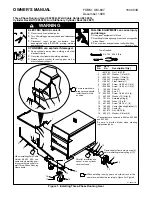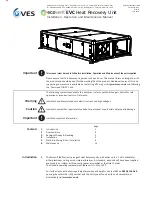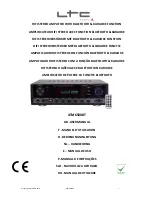
9
TRIMIG
EN
"MANUAL" MODE (FIG V)
To set your device, proceed as follows:
• Choose the welding voltage using the 2 power switches (2 and 7 positions)
Example:
For welding Steel - 1 mm with a Ø 0.8 wire, set the switch to «1»
• Adjust the wire speed with potentiometer (4).
Advice:
The wire speed adjustment is often determined by « the noise »: the arc must be stable and emit low crackling. If
the speed is too low, the arc will not be continuous. If the speed is too high, the arc crackles and the wire will push
back the torch.
"SYNERGIC" MODE (FIG V)
This function automatically controls the wire speed. There is no need to set the wire speed manually.
• Position the wire speed potentiometer (4) in the middle of the « Optimal synergic » zone.
• Select:
- Wire type (3)
- Wire diameter (3)
- Power setting (switch on the front)
To select the right position in accordance with the thickness of the work-piece, please refer to the “synergic mode” table
on the previous page. From the settings chosen, the Trimig determines the optimum wire speed and the device is ready
to weld. It is also possible to adjust the wire speed if necessary by adjusting potenti or – manually (4). The
last welding configuration is saved in the memory automatically (wire diameter, wire type, mode).
ADVICE AND THERMAL PROTECTION
• Trimig should not be lifted by its handles, torch support, or the top of the machine. When lifting the Trimig, ensure the
weight is fully supported at the bottom of the machine. There must be no gas bottle connected during this operation.
• Always respect the basic rules of welding.
• Do not block/cover the ventilation holes of the machine.
• Leave the device plugged in after welding to allow proper cooling down.
• Thermal protection: If the machine becomes too hot, the warning light will illuminate and the machine will stop. Coo
-
ling will take a few minutes, the length of time will also depend on the external temperature.
DUTY CYCLE AND WELDING ENVIRONMENT IN USE
• The welding unit describes an output characteristic of "constant current" type. The duty cycles following the standard
EN60974-1 (at 40°C on a 10mn cycle) are indicated in the table below:
x/60974-1 @ 40°C
I max
60%
100%
Trimig 200-4S
200A @ 30%
140A
120A
Trimig 250-4S
250A @ 30%
180A
140A
Trimig 300-4S et G
300A @ 35%
240A
180A
Trimig 350-4S DUO et G DV
350A @ 35%
270A
220A
Note : The machines’ duty cycle has been tested at room temperature (40°C) and has been determined by simulation.
• These are Class-A devices. They are designed to be used in an industrial or professional environment. In a different en
-
vironment, it can be difficult to ensure electromagnetic compatibility, due to conducted disturbances as well as radiation.
• These devices comply with IEC 61000-3-12, provided that the power of the short-circuit Ssc is equal to or greater than
3.9MVA (2.8MVA for the Trimig 200-4S) at the interface between the machine and the mains power network. It is the
responsibility of the installer or user of the equipment to ensure if necessary by consulting the operator of the mains
electricity, that the equipment is only connected to a power supply where the power of short-circuit ssc is equal to or
greater than 3,9MVA (2.8MVA for the Trimig 200-4S).
Summary of Contents for PROMIG 350 G DV
Page 22: ...22 TRIMIG Trimig 250 4S...
Page 23: ...23 TRIMIG Trimig 300 4S...
Page 24: ...24 TRIMIG Trimig 300 G...
Page 25: ...25 TRIMIG Trimig 350 4S DUO DV 230 400V...










































